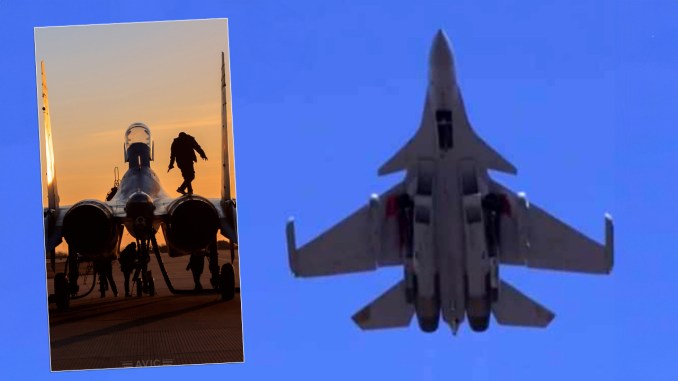
The PLAN certainly needs a supersonic carrier-borne EW jet like the US’s EA-18G Growler.
The J-15D, an EW (Electronic Warfare) prototype variant of the carrier-borne J-15, was featured in an official picture of the Aviation Industry Corporation of China (AVIC) on its Weibo account last week. Leading Chinese military aviation researcher Andreas Rupprecht posted the photo on X, wondering whether this suggests the J-15D might be slated for serial production.
The picture showed a rear shot of the J-15D capturing only the roots of its wingspan, with crews working around it, possibly against the evening’s setting sun. “Interesting official revelation…a J-15D – maybe finally a serial aircraft – was posted today on AVIC’s official Weibo account,” Rupprecht said. (Why this is the ‘D’ variant of the J-15 will be explained subsequently).
Whether or not the J-15D goes into mass manufacturing, it is important to highlight the importance of the fighter in context of China’s burgeoning military aviation, particularly following the sea trials of its third aircraft carrier, the Fujian.
大連で定期整備中の空母”山東(17)”
甲板上にあるのはJ-15Dの模型。
(image via @大公文匯網 ) pic.twitter.com/WszFw84aJT— お砂糖wsnbn (@sugar_wsnbn) July 1, 2022
J-15D’s Glimpses on Social Media
The J-15D had last appeared in a clip from CCTV (China Central Television) in March this year, showing two EW pods in a bottom view while the jet flew overhead. It has also been observed that they are likely the same pods as the ones on the J-16D. Interestingly, China was also inspired by the U.S.’s F-16 C/D Block 52/60, which hasve a conformal fuel tank and a straighter spine to house EW systems, to develop the J-10D.
As it seems, the J-15D has reappeared…
(Via CCTV7) pic.twitter.com/dcg16FMd8K
— @Rupprecht_A (@RupprechtDeino) March 24, 2024
Thus, although it is a prototype variant, this makes the J-15D the third fighter aircraft-based EW platform in the Chinese fleet. The J-15 itself is a Chinese copy of the Russian Sukhoi Su-33, a carrier-borne aircraft. Chinese military observers have said that the J-15D was still being tested, and it was not clear if it had been slated for serial production.
Its first images appeared on social media in 2018. The plane was captured flying in factory colors. It has also been sporting an arrestor hook in the underside at the tail-end. A fresh set of four new images emerged in February 2022, with the plane photographed in factory paint scheme from various angles.
E-Shark J-15D pic.twitter.com/dy4AGmWzoh
— dafeng cao (@dafengcao) June 11, 2018
J-15D pic.twitter.com/d1yeTkys5E
— 東風 EastWind (@eastwind6699) February 2, 2022
J-15D nearing serial production?
To be able to operate from the Fujian carrier, the J-15D would need to have a new front landing gear with an ‘arm’ to lock with its electromagnetic-powered catapult launch system.
A prototype variant, the J-15T, has appeared in open source images over the years. It has been described as a “demonstrator” aircraft and observed to have a single front landing gear door. The ‘arm’ is clearly visible, and two pitot tubes can be seen on the right-side of the front fuselage under the cockpit.
I must admit, at first I was not sure if it would be just an ordinary J-15S twin-seater, but that strange antenna on the spine behind the canopy is shaped more like a thorn on the “D” than the “simple” blade antenna on the “S”. pic.twitter.com/RKlMa4T4AJ
— @Rupprecht_A (@RupprechtDeino) May 16, 2024
As Rupprecht points out in the thread, the J-15D’s antenna on the spine behind the canopy is also distinguishable, being straighter and more vertical, unlike its slanted positioning on the J-15S. Rupprecht also placed the emergence of the photo and the possibility of the type of its landing gear in context for The Aviationist. “At least for the moment (it’s) just a hint that service entry may be close. Since we do not see the landing gear we don’t know what modifications it has.”
China Does Need its Own ‘Growler’
Whether or not the J-15D is going into serial production now, is not known. But two things are certain. One, the PLAN needs a supersonic carrier-borne EW jet, and two, a catapult-enabled one at that.
It is inconceivable that China, desirous of full-spectrum naval blue water capabilities like the US – while launching its third carrier (the Fujian) and planning a fourth – would not have its supersonic frontline naval carrier-borne fighter with organic EW or ELINT (Electronic Intelligence). A fighter-based EW platform is fundamental to its military-strategic goals and inconsistent in the defense technological direction it is heading.
This is especially when the PLAAF (People’s Liberation Army Air Force) has its own EW-capable J-16D and the US Navy possesses the highly potent EA-18G Growler. It was therefore only a matter of time that China would move fast to have a ‘Growler’ of its own, that can jam radars and fire missiles at the same time. The Fujian, which is rapidly being readied for sea and weapons trials before induction, also has an electromagnetic-powered catapult to launch planes.
試作機でないJ-15のカタパルト対応型(すなわちJ-15T)の実機が初確認か。
003型の進水時期を考えればそろそろ出てきてもおかしくない時期でしたね。
(画像の出典は透かし参照) pic.twitter.com/gXwlGM7Rc3— お砂糖wsnbn (@sugar_wsnbn) December 14, 2021
Such a capability is meant to launch heavier planes like the newly developed K-600 AWACS and carrier-borne fighters to take off with their full combat load. This is restricted to self-powered launches on ski-jump carriers like the Liaoning and the Shandong.
Not having a catapult hook-enabled front landing gear version of an EW variant like the J-15D would simply be a waste of developing both the variant and EMALS launcher on the Fujian. The J-15 is a heavyweight-class twin-engine fighter. It has a greater multirole-centric role than the J-35, as it can carry a larger payload of both air-to-air, air-to-sea/surface munitions.
Carrying such a massive loadout along with organic, non-strap-on EW systems accords tremendous tactical flexibility and is a great asset while teaming with many aircraft types. The only thing therefore that remains to be seen is whether the J-15D in the AVIC’s Weibo post has a new front-landing gear. Some informed guesses can be made.
Fusing the J-15T and J-15D
The Fujian’s EMALS catapult will soon be tested over the next year. So will the catapult-enabled front landing gear of the J-15T, to see if it can withstand the stress and shock of being hurled and recovered off the flat-top. The results might inform the development of a catapult-version of the J-15D, with fresh variants with the new front landing gear to operate off the Fujian.
The J-15D’s technology and tactics meanwhile would be refined on the Shandong and Liaoning by the time the J-15T demonstrator finishes testing from Fujian, and PLAN decides to go for serial production for a missionized variant. This mass-production model would have the catapult-friendly landing gear from the J-15T and the wingtip EW pods from the J-15D. To sum up, whether the J-15D will go into serial production is a question of ‘when’ and not ‘if.
- SEO Powered Content & PR Distribution. Get Amplified Today.
- PlatoData.Network Vertical Generative Ai. Empower Yourself. Access Here.
- PlatoAiStream. Web3 Intelligence. Knowledge Amplified. Access Here.
- PlatoESG. Carbon, CleanTech, Energy, Environment, Solar, Waste Management. Access Here.
- PlatoHealth. Biotech and Clinical Trials Intelligence. Access Here.
- Source: https://theaviationist.com/2024/05/20/j-15d-update/?utm_source=rss&utm_medium=rss&utm_campaign=j-15d-update




